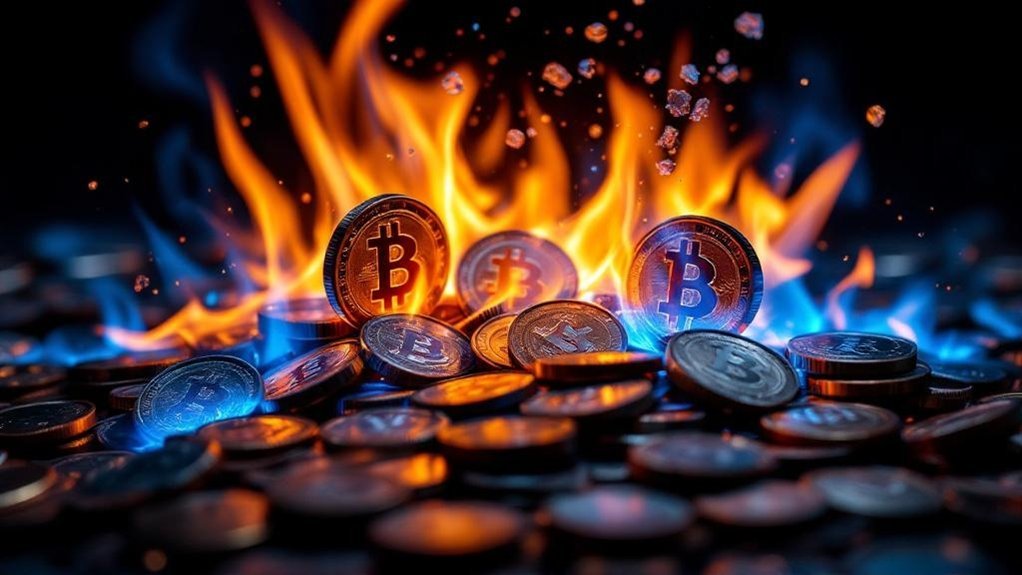Token burning permanently destroys cryptocurrency tokens by sending them to an inaccessible wallet address, similar to a company destroying its own stock. The process removes tokens from circulation, potentially increasing the value of remaining tokens – but there’s no guarantee. It’s all recorded on the blockchain, so no funny business allowed. Projects use burns to combat inflation and show they’re serious about their token’s value. There’s more to this fiery story than meets the eye.

A token burn is crypto’s version of playing with fire – literally destroying digital assets to make the remaining ones more valuable.
Token burning lets crypto projects destroy their own supply, hoping scarcity will ignite higher values for what remains.
It’s a pretty straightforward concept: take a bunch of tokens and send them to a special “burn address” where they’ll never be seen again. Gone. Kaput.
These burn addresses are like digital black holes – once tokens go in, they’re not coming back out. Ever.
Think of it like a company buying back and destroying its own stock, except with way more transparency thanks to the blockchain.
The process helps combat inflation by permanently removing tokens from circulation.
Every token that gets torched is recorded for all to see. No sneaky business allowed.
Projects use this destructive power for a simple reason: to make their tokens more scarce and potentially more valuable.
Basic economics at work – less supply, same demand, higher price. At least that’s the theory.
Some crypto projects go all-in on the burning strategy, scheduling regular token bonfires like clockwork.
Others prefer the surprise approach, burning tokens whenever they feel like shaking things up.
Smart contracts automate and validate the burning process on public blockchains like Ethereum.
Either way, it’s usually the project team or community governance that calls the shots on when to light the match.
The whole process is pretty methodical – announce the burn, send the tokens to their doom, and watch the blockchain confirm their permanent departure.
For token holders, burns can be a welcome sight.
Less tokens floating around means each remaining one might be worth more.
Algorithmic stablecoins frequently burn tokens to maintain their dollar-pegged value.
But let’s be real – burning tokens isn’t some magic formula for guaranteed profits.
It’s just one tool in the crypto toolbox, alongside factors like utility, adoption, and market sentiment.
Still, when projects commit to regular burns, it shows they’re thinking long-term about their token’s value.
The crypto world loves its token burns.
It’s dramatic, measurable, and irreversible – perfect for a space that thrives on bold moves and permanent solutions.
Just remember: while burning tokens might reduce supply, it doesn’t automatically mean prices will go up.
That’s just how crypto rolls.
Frequently Asked Questions
How Long Does It Take for a Token Burn to Complete?
Token burns typically complete in minutes to hours, depending on the blockchain network.
Fast chains like BSC wrap it up quick – sometimes in minutes flat.
Ethereum? Could take longer, especially when gas fees are through the roof.
Network traffic plays a huge role.
Smart contract burns happen almost instantly, while manual burns can stretch over days.
Blame it on the blockchain, folks.
Can Token Burning Increase the Price of Remaining Tokens Indefinitely?
Token burning can’t magically pump prices forever.
While reducing supply can boost token value initially, it’s not a guaranteed path to endless gains. Market forces, demand levels, and external factors play huge roles.
Too much burning actually hurts – it can wreck liquidity and make tokens unusable.
Without real demand growth, even aggressive burning won’t sustain price increases long-term.
What Happens if You Accidentally Send Tokens to a Burn Address?
Sending tokens to a burn address is a one-way trip – they’re gone forever.
No recovery, no undo button, no customer service to call. The tokens become permanently inaccessible since burn addresses lack private keys. Period.
When this happens, those tokens leave circulation permanently, potentially affecting the total supply and market dynamics.
It’s like throwing money into a black hole – except there’s no theoretical way to get it back.
Are There Tax Implications When Participating in Token Burning Events?
Yes, there are significant tax implications for token burning.
The IRS treats it as a disposal event – just like selling crypto. Burning tokens triggers capital gains or losses, depending on the difference between purchase price and value at burn time.
Voluntary burns might qualify as tax-deductible losses, while protocol-mandated burns face different treatment.
Better keep those transaction records – the IRS isn’t exactly known for their sense of humor.
How Can Investors Verify if Tokens Were Actually Burned and Not Transferred?
Investors can track burn transactions through public blockchain explorers, checking if tokens went to verified burn addresses.
Smart contract burn functions provide extra verification, showing tokens are permanently locked. The process leaves a clear trail – transaction hashes, event logs, and Merkle proofs.
Third-party analytics platforms and audit reports offer additional confirmation. No smoke and mirrors here – it’s all transparent on-chain.
